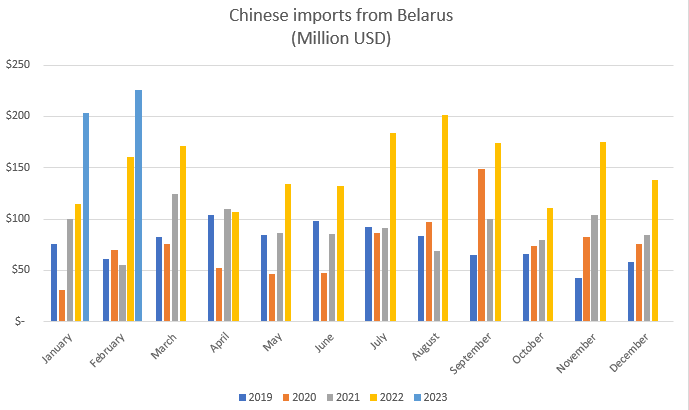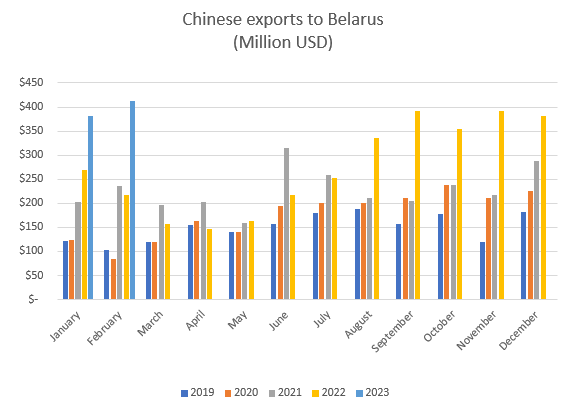China-Belarus trade surged in January and February
U.S. intelligence may have been hacked: some initial thoughts
Minsk’s Ambassador in Beijing, Yuri Senko, claimed earlier this year that January 2023 saw a 200 percent increase in Belarusian exports to China. He was exaggerating, at least according to official Chinese trade data, but directionally correct. Belarusian exports to China rose 78 percent in January 2023 from the same prior-year period, while Chinese exports to Belarus increased 42 percent. Bilateral trade over the January-February period (aggregated together to normalize Lunar New Year effects) has increased by a massive 238 percent from 2019 levels.
Sources: PRC General Administration of Customs, Author’s Calculations
Sources: PRC General Administration of Customs, Author’s Calculations
It’s difficult to parse how much these surging trade flows are commercially or politically determined. Chinese companies are surely taking advantage of Belarus’ estrangement from Western markets, but it’s also possible that Beijing is using Minsk as a cutout for trade with Russia. Whatever the motivation behind surging China-Belarus bilateral trade ties, Beijing’s growing economic footprint is propping up the Belarusian economy, limiting the need for Moscow to subsidize Minsk, and indirectly aiding the Russian economy and war effort.
Belarus’ shrinking quasi-sovereignty
Belarusian dictator Alexander Lukashenko met with his Russian counterpart in Moscow on Thursday for talks, where they discussed siting tactical nuclear weapons on Belarusian territory. As many analysts have pointed out, Putin’s deployment of weapons on Belarusian territory seem to violate the recent Sino-Russian joint statement, which claimed that “All nuclear-weapon states should refrain from deploying nuclear weapons abroad and withdraw nuclear weapons deployed abroad.” (所有核武器国家都不应在境外部署核武器并应撤出在境外部署的核武器。)
As has been discussed previously in The Report, however, it’s not clear if Beijing regards Belarus as “outside of the borders” of Russia, or”境外.” The Chinese embassy in Moscow has, after a year-long pause, begun including Belarus-related updates in its “China-Russia relations” page, while authoritative PRC state media outlet The People’s Daily included an interview on Belarusian language study in its Russia section. Since the PRC may believe that there are certain parallels between Belarus and Taiwan, it wouldn’t be surprising if Beijing is quietly reducing distinctions between Belarus and Russia.
Will Moscow, with Beijing’s tacit or explicit support, remove Lukashenko? Potentially (probably?), but likely not until after the war, as an analysis out of Germany’s SWP suggests.
Moscow and Beijing may find Belarus’ quasi-sovereignty useful, especially in the near-term. Lukashenko can, with some plausible deniability, float diplomatic initiatives on behalf of the Kremlin; Minsk may also, despite falling under sanctions, also serve as a conduit for Sino-Russian trade.
It’s worth watching Lukashenko’s future closely. The dictator has often appeared out of his depth in recent years, especially in 2020, where his bungling of COVID and presidential elections led to massive protests that threatened the regime. Despite these setbacks, however, Lukashenko has consistently demonstrated his ability to maneuver between larger, more powerful actors. Lukashenko’s ability to adapt to new realities may determine if Belarus maintains its quasi-sovereignty, or if it is finally subsumed by Russia.
Finished U.S. intelligence products posted online ahead of likely Ukrainian military counteroffensive
The New York Times and Washington Post are reporting on what appears to be a major breach of U.S intelligence, as someone purporting to be an internet user reportedly leaked U.S. intelligence, including military intelligence, in a video game chat. Thomas Rid of SAIS has a useful analysis of some initial topline implications. Rid notes that the leak is “unusually” of finished intelligence reporting.
The leak’s nature, timing, and content, are all significant. The leak’s public nature has substantially raised the probability that Western counterintelligence investigators will uncover the source of the leak. Whoever was behind the leak knew that they could probably only leak once. The information was leaked on February 28 and March 2nd, ahead of Ukraine’s likely (and long-anticipated) spring counteroffensive. The leak appears to have contained significant military intelligence about US capabilities and Ukrainian war plans. More important than the leak’s contents, however, was what was missing. Western intelligence officials likely don’t know what was left out, or why. The leak has raised questions about the security of Ukrainian military plans and may be aiming to deter or at least limit the offensive.
Who is behind the leak? Is it from a disgruntled insider threat? A Russian or Chinese human source? It seems improbable – but not impossible – that Russia acquired this information through its own SIGINT capabilities, which appear to have been severely degraded over the past year. The PRC is a much more capable SIGINT actor. While it’s far too soon to say who is behind the leak, the leak’s nature, timing, and content suggest that someone may be aiming to disrupt the Ukrainian counteroffensive.
Joseph Webster is a senior fellow at the Atlantic Council and editor of the China-Russia Report. This article represents his own personal opinion.
The China-Russia Report is an independent, nonpartisan newsletter covering political, economic, and security affairs within and between China and Russia. All articles, comments, op-eds, etc represent only the personal opinion of the author(s) and do not necessarily represent the position(s) of The China-Russia Report.





Belarus is being prepared to be used against NATO as Ukraine was used against Russia. This is why Russia gave them nukes. China is broke, as anyone who pays attention to banking knows. You are correct that this is cut-out trade. This is Belarus's strategic purpose.